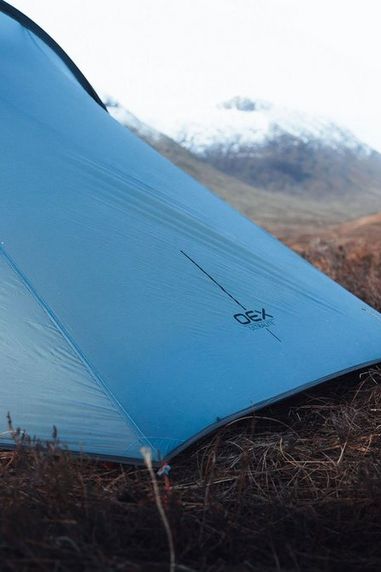Having taken your time to find and purchase your ideal tent, you’ll certainly want it to last for more than a couple of camping trips. That’s where after care comes into the equation. Below is an expert's guide to the products and best practice required in order to keep your tent in mint condition.

Before Your Trip
Get into the habit of pitching your tent at home, before you head to the campsite. Not only does this allow you to practice setting it up and packing it away, it also means you can check for rips and tears as well as damaged zips, poles or air beams. You’ll be able to see if anything is missing too – count up your pegs and buy some spares to be on the safe side!
It’s much better for things to go wrong in your garden rather than in a field away from home. At least this way you’ll have time to put things right in time for your trip.
Tip: Avoid damaging your tent during the pitching process - lay it out correctly and follow the manufacturer’s instructions.
Cleaning & Drying Your Tent
It might seem like it isn’t worth the hassle, but keeping your tent clean and dry will ultimately extend its life.
While the tent is set up, begin by sweeping up any debris that has made its way inside. You can vacuum it if you like, but a dustpan and brush will usually do the trick. If the dirt is being stubborn, have a go at wiping it clean with a wet cloth or sponge.
We all know the outside of a tent can get very grubby, very quickly – especially if the weather gods aren’t on your side. Fortunately, tent fabric is pretty easy to wipe down. Mud and bird poo will usually come off with a soapy sponge or cloth (you can even use wet wipes if you have them handy). Remember though, never use detergent-based products as they are likely to cause damage to the flysheet’s waterproof coating.
Packing your tent away correctly is just as important as setting it up correctly. Primarily, it’s important that everything is as dry as possible when you start putting it away.
Even if it hasn’t rained, condensation can leave moisture on the surface of the flysheet. Shake the tent vigorously to disperse the droplets, or wipe it down with clean, dry cloth before leaving it to air outside.
If the rain persists while packing up, you may have no choice but to put everything away while it’s still wet. Don’t worry though, you should be OK as long as you manage to get it out again as soon as possible when arriving home.
The best thing to do is to pitch the tent in your garden and let it dry outside. If you don’t have the space, try hanging it over the washing line. The quicker you do this, the more chance you have of preventing mould and musty smells finding their way into the fabric.

Tent After Care Essentials
There are some items that you should always take with you in order to keep your tent in the best possible shape for the duration of your camping trip.
Replacement Tent Pegs
Be honest, have you ever come home with a full complement of tent pegs?
Throw some spares in the bag so that you’re still good to go if you bend, break or lose pegs during your trip.
Duct Tape
So often a lifesaver on the campsite, a roll of gaffer tape is always a good thing to have around. It’s ideal for quick fixes, whether it’s repairing snapped poles, punctured air beams or torn flysheets. It's rarely a permanent fix, but it could save your weekend.
Tent Footprint
A footprint is a removable groundsheet that can be placed under your tent to prevent the base of your tent getting muddy and wet. Having a footprint in place also means that you’re less likely to damage your tent’s sewn-in groundsheet on the rocks and debris beneath.
At Blacks, we have footprints tailor-made for specific tents, find yours here.
Tent Repair Kit
A basic tent repair kit typically includes equipment for fabric repair, puncture repair and pole repair. Keep one handy just in case you need to carry out repairs while you’re away.
Seam Sealant
Seam leaks can occur from time to time. Use specialist seam sealant to repair the leaking section, leaving it to adhere to the fabric for a couple of days. After that, you should be waterproof again!
Reproofing Your Tent
Tents don’t stay waterproof forever, and it’s pretty easy to spot when yours needs reproofing. If water is no longer beading on the surface of the fabric, or condensation is beginning to build up inside the tent, then it’s likely that reproofing is required as soon as possible.
We recommend Nikwax Solar Proofer as a highly effective way of restoring your tent’s water repelling capabilities.

Packing Your Tent Away Correctly
Packing Away
The secret to keeping your tent in tiptop condition for your next trip is to pack it away carefully. Prevent your tent from becoming damaged by following our suggestions and the manufacturer packing instructions.
- Ensure the inside of the tent is completely clean of debris and dust
- Open the tent and leave it to air for a few hours before you start packing it away (if the weather is dry)
- Partially zip the tent doors leaving some room for air to escape
- Unpin the poles from the pins and collapse the tent with the poles still in
- Push (don't pull) the tent poles out of the sleeves and fold them
- Have a person stand each side and fold the tent to match the width of the bag, pushing air out as you unfold.
- Place the bag for poles and pegs on top of your folded tent and roll as tight as possible
- Tie the tent up and place it into its bag
Storing Your Tent
Another essential step towards maximising the life of your tent is to store it correctly.
Firstly, avoid packing your tent away while it’s still wet – this can cause mould to form, which in turn can damage the fabric and leave behind nasty smells.
When storing the bag itself, find a cool, dry area such as a garage or loft and lay it on a flat surface. Try not to place the bag on its end as this could result in damaged poles.
Look after your tent, and your tent will look after you
A new tent represents a significant investment, so you’ll definitely want it to last for more than a couple of camping trips!
Although it may seem like extra hassle at the time, following all the advice above is definitely worth it in the long-run as it will allow you to enjoy your tent for years to come.




Comments